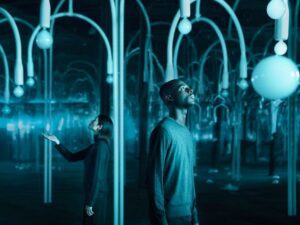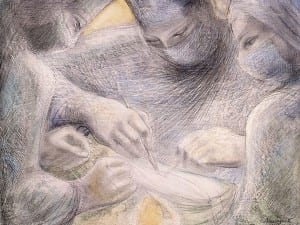Tom Price, who was born in London in 1981, studied at Chelsea College of Art and the Royal College of Art Sculpture School. In 2009 he was featured on BBC Four television documentary, Where is Modern Art Now? He was awarded the Arts Council England Helen Chadwick Fellowship. In 2010 he featured on BBC Four’s, How to Get A Head in Sculpture. He was also included in 10 Magazine’s Ten Sculptors You Should Meet. His statues, which are currently on display at Yorkshire Sculpture Park, trace the evolution of Price’s approach to the male figure.
The exhibition at YSP employs bronze statuary in ways that subvert the tradition of sculpture. Bronze statues traditionally represent individuals of great significance within canons and traditions of thought and practice. The British tradition can be linked to an interest in similar practices employed in the Classical civilisations. Usually commemorated in this way are white men, typically in public places in Britain of civic interest. A well-known example would be the statues that can be found in Trafalgar Square in London. Price’s statues represent anonymous subjects: black men in the street, along with images from print media. The status of these anonymous subjects is raised by referencing the tradition of bronze statuary in this way and thereby subverts the power relations of the hierarchies reflected.
A nine foot tall bronze statue with black patina of a young black man stands in the grounds of YSP. Its title is Network. He is broad-shouldered and dressed in urban clothing. The subject is glancing at his mobile phone. His downcast features subvert the tradition of representing heroic, powerful figures by impressing for his vulnerability. While the figure is charismatic for the great scale of its dimensions, it is also modest: powerful and powerless at the same time.
Price continues to use the scale of the statues to undermine both the sculptural tradition employed and the hierarchical inequities implied. Elsewhere in this exhibition the visitor is invited to view male nudes – the first male figures made by Price. Mounted on plinths, the viewer might expect a representation of a famous aristocrat or politician. The small scale of the nudes speaks of vulnerability, as does the posture of the figures. Their features indicate a lugubrious weariness. These powerless nudes are given the titles of roads in Brixton (Price’s home). The streets themselves are, somewhat ironically, named after individuals of significance within canons of thought and practice in Western culture.
Price is interested in the mental narratives that result in the individual’s reaction, formed of subconscious and conscious assumptions and judgements, when we first meet someone. He explores posture, expression and status with the use of bronze statues and the relevance they have to current ways of thinking and behaving. Bronze heads can be found displayed on plinths. They are sprayed with car paint, thus adding a contemporary edge to what might have been an old or even ancient representation. Where a heroically arranged physiognomy might be expected, again that same downcast vulnerability is overwhelmingly detectable. Price employs one of the oldest media to be manipulated by man and makes an extremely relevant appeal to contemporary understanding and empathy.
Tom Price, until 27 April, Bothy Gallery & Lakeside, Yorkshire Sculpture Park, Wakefield, WF4 4LG.
Daniel Potts
Credits
1. Network, 2012. Courtesy the artist and Hales Gallery. Photo Jonty Wilde.





